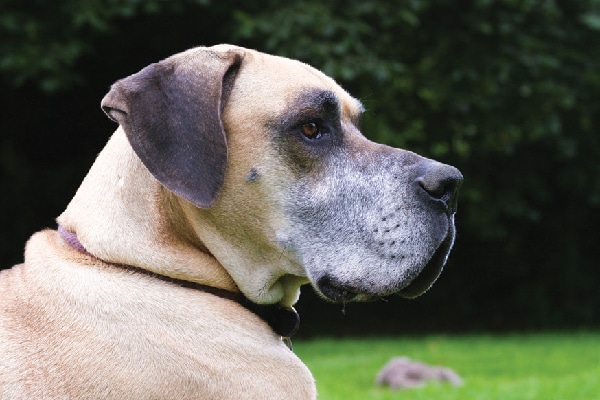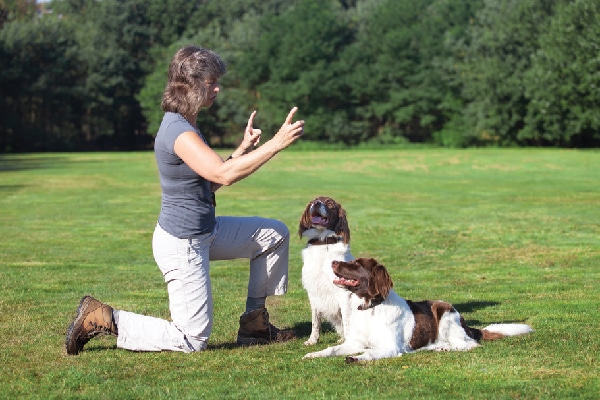Age 10 is a milestone for a human, and it’s a big deal for a dog, too. When a dog hits age 10, he is firmly in his senior years.
My Australian Cattle Dog mix, Candy, just turned 10. She is a medium-sized dog, weighing 60 pounds. Even though she’s technically a senior at 10, she still plays with my younger dog, runs around the yard and has a spring in her step. But if I look closely, I can see her eyes are starting to get a little cloudy, and we have to yell louder than we used to when we call her to come. But at 10, Candy still has a lot of life left in her.
What can you expect from your dog at age 10? That all depends on the size of your dog. Smaller dogs age more slowly than medium and large dogs, so what they experience at age 10 can often be different than what happens to dogs who are bigger. Let’s take a look at age 10 for both smaller and larger dogs.
Small dogs

If you have a little dog, like a Chihuahua, Jack Russell Terrier or Pomeranian, or a mixed small breed that weighs less than 30 pounds or so, your dog is considered middle-aged at age 10.Small dogs generally live longer than medium to large dogs, and reaching the age of 16 or 17 is not that unusual.
So, for these dogs, age 10 is just a little past midlife.
Small-breed dogs at this stage of their lives have slowed down since their puppy days but still have enough energy to play. Depending on the dog, they may even still have the desire to frolic, too.
Even though small dogs at age 10 still have energy, they will start showing some signs of aging. Dental care is particularly important at this age, especially if a dog’s teeth and gums have not been maintained in the past. Periodontal disease, loose and infected teeth, and bad breath can also start to show up by this age in small dogs with neglected mouths. If your small dog hasn’t had much dental care until now, this is good time to start. Take your small dog to a veterinarian to have his teeth and gums examined.
In fact, if you aren’t doing it already, make a point of taking your dog to the veterinarian at least once a year for an examination. Your vet can do a complete blood panel on your dog to make sure he’s healthy and to use it for a baseline in the future. If your dog is having any issues that might warrant a special diet, your vet will help you switch to the right food.
Medium to large dogs

Age 10 can be more significant for bigger dogs because they age faster than their smaller counterparts. Labrador Retrievers, German Shepherd Dogs, American Pit Bull Terriers and mixed breeds weighing 35 to 70 pounds are typically considered seniors by the time they hit 10 years of age. Very large breeds, like Newfoundlands and Great Danes and mixes weighing 80 pounds or more, are usually well into old age by the time they reach 10.
By the time your dog hits the age of 10, you may notice that he is starting to slow down. While he still may still want to run and play, and may still be able to do it, he may also be a bit stiff when he rises from sleeping due to developing arthritis and may run out of steam sooner than he used to when he was younger. He may not hear as well, either.
If you aren’t doing it already, consider putting your dog on a joint supplement to help with arthritis. Commercial supplements containing glucosamine, chondroitin and the organic compound MSM (Methylsulfonylmethane) can be helpful. If the arthritis is causing your dog a lot of pain, talk to your vet about a prescription medication.
Dogs this size who have reached the age of 10 should see a veterinarian twice a year for an exam. The vet will check your dog’s teeth and ears, and listen to his heart and lungs. The vet may also recommend blood work at least once a year to get an idea of your dog’s overall internal health. If your dog is having any liver or kidney issues — something that can happen when dogs start to get older — the problems will be revealed in the blood results. Your vet may suggest a special diet to help with these issues.
If your 10-year-old dog is starting to lose his eyesight, or is feeling pain from arthritis, you may notice some signs of anxiety in your pet. Shaking, cowering or refusing to participate in activities he used to enjoy can all be signs that something is bothering your dog. Take him to a veterinarian for a complete exam. Once you know what is causing his distress, your vet can help you with pain medication if arthritis is the issue or advice on how to help your dog cope with the loss of his sight.
At age 10, your dog still has plenty of love to give and life to enjoy. Support him with quality food, plenty of attention and regular vet visits. Remember that exercise is still important at this age, and keeping his weight down will help with any arthritis that might be developing. With good care, you’ll have him for years to come.
Should you teach your 10-year-old dog sign language?

If your 10-year-old dog still has his hearing, this is a good time to teach him sign language. Eventually his hearing may disappear altogether, so using visual cues now will help later on when he can’t hear your words. Learn the visual cues at least for:
- His name
- Yes or good boy
- Sit
- Come
- Stay
- Lie down
- Sleep time
A trainer can work with you on teaching your dog these visual cues, or you can go to deafdogsrock.com to see signs that organization recommends using with deaf dogs.
Read more about dog health and care on Dogster.com:
- Cherry Eye in Dogs — Prevention and Treatment
- 5 Home Remedies for Fleas on Dogs
- Why Do Dogs Howl? 5 Reasons
About the author: An award-winning writer and editor, Audrey Pavia is a former managing editor at Dog Fancy magazine and former senior editor of The AKC Gazette. She is the author of The Labrador Retriever Handbook (Barrons) and has written extensively on horses, as well as other pets. She shares her home in Norco, California, with two rescue dogs, Candy and Mookie.
Featured Image Credit: kreinick | Getty Images.





